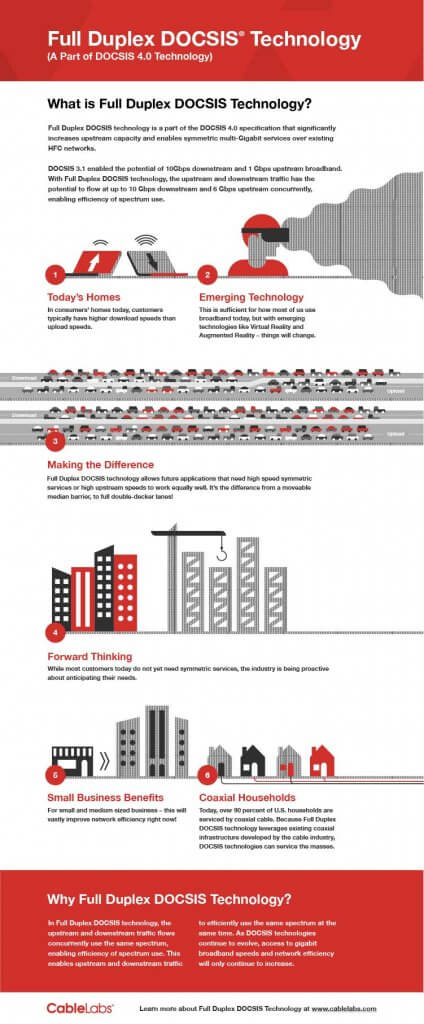10G
A Major Leap Toward 10G: CableLabs to Complete DOCSIS® 4.0 Specification in Early 2020

In a continuing effort to meet the industry’s recently announced 10G goal, CableLabs is wrapping up the first major update to its DOCSIS specification since DOCSIS 3.1. DOCSIS 4.0 technology will enable the next generation of broadband over cable’s existing hybrid fiber coax (HFC) networks, delivering symmetrical multi-gigabit speeds while supporting high reliability, high security and low latency.
What is DOCSIS 4.0 Technology?
Building on the success of DOCSIS 3.1 technology, which the cable industry is leveraging globally to deliver 1 Gbps services to end users, DOCSIS 4.0 technology supports a rich and flexible feature set of capabilities. The technology will enable multiple system operators (MSOs) to deliver on the 10G vision and includes support for Extended Spectrum DOCSIS (ESD) and Full Duplex DOCSIS (FDX) capabilities. These are complementary technologies that jointly or individually represent key elements to deliver on the 10G promise. By supporting these technologies, cable operators can deliver a richer feature set of capabilities and facilitate a cost-effective upgrade to a better, faster and more efficient network.
- Full Duplex DOCSIS Capabilities
FDX DOCSIS technology allows for concurrent use of spectrum for both upstream and downstream traffic, thus doubling the network efficiency by leveraging the HFC network characteristics, self-interference cancellation technology and intelligent scheduling. DOCSIS 4.0 technology is also backwards compatible with previous generations of DOCSIS technologies.
- Extended Spectrum DOCSIS
With ESD, operators can leverage a lot more usable spectrum on their existing HFC networks—up to 1.8GHz. That’s 600MHz more than the 1.2GHz available to them under the current DOCSIS 3.1 standard. The DOCSIS 4.0 working groups are in full swing, focusing on developing and adding the ESD requirements to the DOCSIS 4.0 specifications.
This boost in capacity provided by DOCSIS 4.0 technology will enable MSOs to provide multi-Gbps symmetric services to residential and business customers, and support the next generation of user experiences such as immersive media experiences in addition to serving as a catalyst for a new wave of innovations.
Toward 10G
DOCSIS 4.0 technology is a major step toward reaching the industry’s 10G goal. You can learn more about the road to 10G and its technologies here. If you’re near New Orleans or attending the SCTE Cable-Tech Expo next week, register for our vendor forum, Envision, to get the exclusive opportunity to learn about the technologies the industry is working on. At Envision, which will take place on September 30, you can expect to hear updates about DOCSIS 4.0 technology and 10G, including how 10G will enable mobile and wireless networks.

DOCSIS
CableLabs Publishes Full Duplex DOCSIS® Specification

Recently, in a significant step for the cable industry, we announced the successful completion of the Full Duplex DOCSIS® 3.1 specification (now a part of DOCSIS 4.0 technology). Today, we are pleased to announce the release of the DOCSIS® v3.1 Physical Layer Specification, which incorporates the addition of Full Duplex in Annex F per PHYv3.1-N-17.1771-6. The specification is designed to enable cost-effective solutions for cable operators for faster broadband speeds and brings peak upstream of up to 6 Gbps and downstream up to 10 Gbps.
Current DOCSIS networks are well suited to meet today's customer’s demands and needs. Full Duplex DOCSIS networks (now a part of DOCSIS 4.0 technology) enable operators to significantly increase the network’s upstream capacity and be ready for future applications, such as the increasing use of IoT devices, telemedicine, video chats, and virtual reality. Watch the video below to see how Full Duplex DOCSIS technology (now a part of DOCSIS 4.0 technology) solves this problem by enabling simultaneous upstream and downstream transmissions in the same spectrum over existing hybrid fiber/coax (HFC) networks, significantly increasing upstream capacity.

DOCSIS
CableLabs Completes Full Duplex DOCSIS Specification

“In the United States, more than 90 percent of households are connected to an HFC (hybrid fiber-coaxial) network, and consumers typically have higher download speeds than upload speeds. By enabling Full Duplex DOCSIS (now a part of DOCSIS 4.0 technology), the upstream can flow up to 6 Gbps and downstream traffic can flow at up to 10 Gigabits concurrently, enabling the efficiency of spectrum use.” -- Phil McKinney, president and chief executive officer of CableLabs
The number of connected devices and bandwidth-hungry online experiences are expected to increase exponentially in the next decade. Also, with the continuous development of new applications that enable new experiences, such as augmented reality and virtual reality, an increase in upstream capacity demand is a matter of “when” and not “if." Operators are continuously challenged to find cost-effective solutions to meet this growing demand for faster broadband speeds. With a focus on solving this challenge of the future, CableLabs recently completed the Full Duplex DOCSIS® (now a part of DOCSIS 4.0 technology) specification.
Full Duplex DOCSIS (now a part of DOCSIS 4.0 technology) technology builds on the successful completion of CableLabs’ DOCSIS 3.1 specification, which made deployments of 10 Gbps downstream and 1 Gbps upstream broadband possible. Full Duplex DOCSIS technology (now a part of DOCSIS 4.0 technology) improves upon the DOCSIS 3.1 standard by:
- Significantly increasing upstream capacity
- Enabling symmetric multi-gigabit services over existing hybrid fiber-coaxial (HFC) technology
- Ensuring that cable operators are ready to meet future usage needs for technologies, such as virtual and augmented reality - although widespread consumer demand for high speed upstream is not yet here, operators need to be prepared when the time comes
Current DOCSIS networks have to juggle available upstream and downstream traffic. Full Duplex DOCSIS technology (now a part of DOCSIS 4.0 technology) supports multi-gigabit symmetric services by enabling concurrent transmissions in the same spectrum, providing the ability to increase the upstream capacity without sacrificing downstream capacity. This has the potential to greatly improve network efficiency and, in turn, customer experience.
Starting from Full Duplex DOCSIS (now a part of DOCSIS 4.0 technology) as an internal innovation, CableLabs developed this solution in collaboration with our members and industry partners, enabling cable operators to deliver multi-gigabit symmetric services. Full Duplex DOCSIS technology (now a part of DOCSIS 4.0 technology) offers high speeds over the existing infrastructure and is less expensive to deploy than fiber, while still maintaining backwards compatibility with previous generations of DOCSIS technology.
You can read more about our Full Duplex DOCSIS (now a part of DOCSIS 4.0 technology) specification effort in my article “Full Duplex DOCSIS Technology: Raising the Ante with Symmetric Gigabit Service.” Make sure to check our website later this month for the complete Full Duplex DOCSIS (now a part of DOCSIS 4.0 technology) specification.
Technology
5G For All: The Need for Standardized 5G Technologies in the Unlicensed Bands
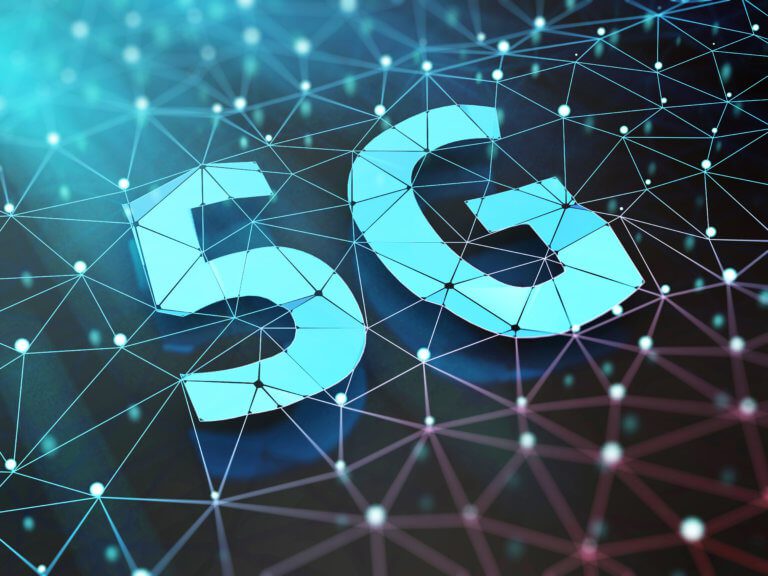
Wherever you turn in the wireless ecosystem today, 5G is the buzzword and the popular kid on the block… well, at least in some blocks. 3GPP, a third generation partnership project that defines specifications for GSM networks and radio access technologies, is working on developing the 5G standards at an accelerated pace, thus emphasizing the importance of 5G in the evolution of mobile networks. But, what is missing in the picture, is an equal emphasis and urgency in developing standardized 5G solutions for the unlicensed bands.
--
According to the FCC:
Unlicensed Spectrum: “In spectrum that is designated as "unlicensed" or "licensed-exempt," users can operate without an FCC license but must use certified radio equipment and must comply with the technical requirements, including power limits, of the FCC's Part 15 Rules. Users of the license-exempt bands do not have exclusive use of the spectrum and are subject to interference.”
Licensed Spectrum: “Licensed spectrum allows for exclusive, and in some cases non-exclusive, use of particular frequencies or channels in particular locations. Some licensed frequency bands were made available on a site-by-site basis, meaning that licensees have exclusive use of the specified spectrum bands in a particular point location with a radius around that location.”
--
The unlicensed spectrum has a history of delivering connectivity to the masses at unparalleled scales and economies. Taking Wi-Fi as a proxy for the unlicensed spectrum, by 2020, it is expected that the total shipment of Wi-Fi devices will have a user base of nearly 12 billion devices and the total shipments of Wi-Fi devices will surpass a whopping 28 billion. (Note: world population is forecasted to be 7.7 billion in 2020!).
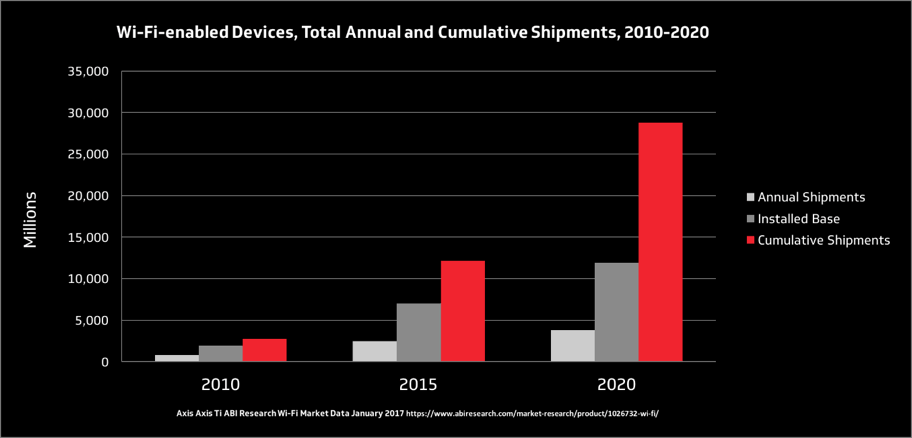
One of the fundamental drivers of the success of Wi-Fi is its use of unlicensed spectrum because the innovation enables the availability of Wi-Fi for everyone with a significantly lower cost and complexity of deploying a wireless network. Additionally, unlicensed spectrum plays a critical role in the success of licensed spectrum technologies. In 2016, 60% of mobile traffic was offloaded to the unlicensed spectrum. This means that mobile networks had to increase capacity by 250% if offloading to unlicensed spectrum was not viable. However, the user experience when switching between mobile networks and Wi-Fi has not been ideal due to a lack of interoperability.
3GPP is now looking at enabling 5G technologies in the unlicensed bands; specifically, 3.5 GHz, 5 GHz and 60 GHz. The study led by Qualcomm was approved in March of 2017, with the results expected to be handed off to 3GPP in June of 2018 for review. While this is exciting news for fans of unlicensed spectrum, it comes at a slower pace than its licensed spectrum counterpart. It is expected that 3GPP will finalize the licensed spectrum Non-Standalone (NSA) 5G enhanced mobile broadband specifications by March of 2018, thus enabling 5G network deployments in early 2019.
Although the schedule is not ideal, it is a step in the right direction. The popularity of the unlicensed spectrum (2.4 GHz and 5 GHz) has driven high levels of congestion. With the continuous increase in user demand, spectrum depletion is a real risk. Fortunately, the 60 GHz spectrum offers a huge swath of underutilized spectrum that is ripe for deploying 5G standalone networks within it. The 60 GHz band has 14 GHz of available spectrum (57 GHz – 71 GHz), which on its own is larger than all the licensed spectrum that is being considered for 5G networks, including licensed spectrum for 2G/3G/4G mobile networks!
We have addressed the business case for 5G technologies in the unlicensed band, but what’s in it for the end user? The ability to make high-speed low latency wireless networks widely available has the potential to significantly disrupt what’s possible in our everyday lives, such as in education, healthcare, transportation, commerce, the way we work, entertainment, and most importantly, the way people connect with each other. Additionally, the availability of high-speed low latency wireless networks enables a new platform for innovation, on which applications we have yet to think of will be developed. The possibilities are endless and limited only by our imagination. As an example, take a look at our short video The Near Future: A Better Place here.
Harnessing the capabilities of 5G technologies and coupling it with unlicensed spectrum so that users can enjoy a seamless wireless experience across licensed and unlicensed bands is one of those truly rare instances where 1 + 1 = 3. What we cannot afford is to not drive standardized 5G technologies in the unlicensed band at a fast pace, because we would miss out on what the coupling of 5G and unlicensed spectrum has to offer.
--
You can find out more about what CableLabs is doing in this space by reading our Inform[ED] Insight on 5G here. Subscribe to our blog to find out more about 5G in the future.
DOCSIS
Full Duplex DOCSIS® Specification Effort Launches

During the CableLabs 2016 Winter Conference, CableLabs announced the Full Duplex DOCSIS (now a part of DOCSIS 4.0 technology) specification project that will significantly increase upstream speeds on the DOCSIS network. The announcement of the Full Duplex DOCSIS (now a part of DOCSIS 4.0 technology) extension of the DOCSIS 3.1 specification, and its potential of offering multi-Gbps symmetric services over the HFC network, created a lot of excitement in the industry. Since then a lot has been going on behind the scenes.
CableLabs has been actively collaborating with the vendor community to further refine the concept and system architecture of a Full Duplex DOCSIS (now a part of DOCSIS 4.0 technology) system. The ecosystem support for the Full Duplex DOCSIS technology (now a part of DOCSIS 4.0 technology) has been staggering, with many vendors collaborating and contributing to the development of the technology. A recent example is Cisco’s contribution of a new silicon reference design of a digital echo canceler that maximizes the use of HFC capacity to provide a scalable multi-gigabit return path.
In June, CableLabs officially launched the Full Duplex DOCSIS (now a part of DOCSIS 4.0 technology) project, transitioning it from the innovation phase to the R&D phase focused on specification development. Our first face-to-face meeting held in Louisville last month featured strong participation from CableLabs members and the vendor community including several new participants. Working group meetings will be held on a regular basis until the specification development is complete.
Full Duplex DOCSIS technology (now a part of DOCSIS 4.0 technology) will radically change the art-of-the-possible on the HFC network by delivering an unparalleled experience to cable customers.
DOCSIS
Full Duplex DOCSIS® Technology: Raising the Ante with Symmetric Gigabit Service

Building on state of the art technology, ongoing DOCSIS 3.1 technology deployments have squarely set the cable industry on the path to deliver Gigabit services over HFC networks.
But there’s more to come! A newly unveiled project at CableLabs illustrates how DOCSIS 3.1 technology provides the basis for continued evolution of system capacities by supporting symmetric multi-Gigabit service over the cable network. During its recent 2016 Winter Conference, CableLabs unveiled a Full Duplex DOCSIS technology (now a part of DOCSIS 4.0 technology) which applies emerging techniques from wireless networks to achieve a breakthrough increase in the upstream speeds for DOCSIS delivered broadband service. A Full Duplex DOCSIS (now a part of DOCSIS 4.0 technology) network is a prime example of the CableLabs 2.0 vision using its rich innovation funnel of technologies to transform the industry.
How is full duplex different from existing technologies?
Existing technologies mostly use either Frequency Division Duplexing (FDD) or Time Division Duplexing (TDD). In FDD, upstream and downstream (or uplink and downlink in the terms of the wireless world) traffic operate separately in dedicated parts of the spectrum. In current DOCSIS network deployments, the lower part of the spectrum is dedicated for upstream traffic and the upper part of the spectrum is dedicated for downstream traffic. In TDD, the upstream and downstream traffic share the same spectrum, but take turns in using the spectrum, similar to how Wi-Fi, or DSL, operate. In Full Duplex communication, the upstream and downstream traffic use the same spectrum at the same time, doubling the efficiency of spectrum use. A DOCSIS 3.1 Full Duplex network (now a part of DOCSIS 4.0 technology) provides the peak speeds and flexibility of TDD solutions, but one-ups both TDD and FDD with double the capacity.

Today’s Technology Duplex: Time Division Duplex
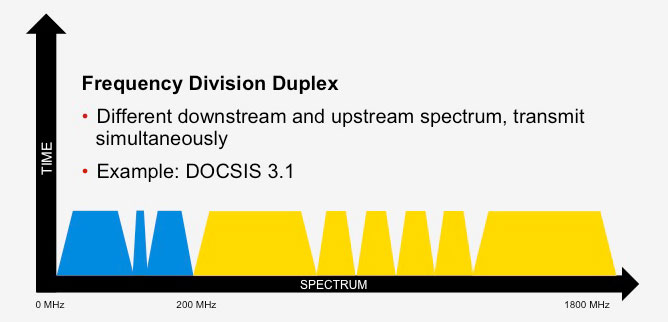
Today’s Technology Duplex: Frequency Division Duplex

Full Duplex DOCSIS (now a part of DOCSIS 4.0 technology)
Using a combination of Passive HFC and the self-interference cancellation and intelligent scheduling of DOCSIS 3.1 technology, CableLabs has built a solution that proves the viability of full duplex communication. Its approach significantly increases upstream data capacity in order to enable symmetric multi-Gigabit broadband data services for consumers and the enterprise. These developments are expected to yield DOCSIS 3.1 network performance of up to 10 Gbps symmetrical on 1 GHz HFC networks, with the potential for even higher performance by utilizing spectrum that is currently available for future expansion above 1 GHz.
One of the compelling attributes of a Full Duplex DOCSIS 3.1 network (now DOCSIS 4.0 technology) for the next evolution in HFC delivery is the strong foundation DOCSIS 3.1 technology provides. Our design and analysis shows that the existing Physical and MAC layer protocols in DOCSIS 3.1 technology can largely support this new symmetric service. The evolution to a DOCSIS 3.1 Full Duplex network (now a part of DOCSIS 4.0 technology) is an incremental evolution of DOCSIS 3.1 technology and will support both backward compatibility and coexistence with previous generations of DOCSIS network deployments.
So what’s next for the Full Duplex DOCSIS 3.1 technology (now a part of DOCSIS 4.0 technology)?
Over the next few months, we will engage with a team composed of our members and vendors who can help us further validate and mature the technology. Following which, if all signs remain positive, the project will transition from an innovation effort into an R&D project, open to all interested participants.
We are excited about this development effort, and look forward to its further evolution. Stay tuned to this blog for more exciting news from CableLabs.
Dan Rice also contributed to this article.
Belal Hamzeh is Vice President of Research & Development in Wireless Technologies group at CableLabs.
Consumer
DOCSIS 3.1 Technology: Spec to Product in One Year

Around this time last year, CableLabs kicked off the first DOCSIS® 3.1 interoperability event. Looking back, it is amazing how far we have come.
Over the last year, CableLabs has held seven DOCSIS 3.1 interoperability events that provide manufacturers with the opportunity to work together on interoperability, development, and compliance. A total of 27 vendors across cable modem, head-end, and test equipment manufacturers have participated so far. Over the course of these events, vendors have continued to demonstrate improvements in product maturity.
Additionally, CableLabs has completed seven dry run events which provided vendors with additional development opportunities and evaluation of product readiness for certification and field trials through joint test execution between CableLabs and the vendors. This progress has paved the way for CableLabs to officially open the door for device certification submission and for cable operators to plan their field trials. While we can’t say much about what is going on in our certification labs, we can say it is like a beehive in there! CableLabs will be continuing the interoperability and dry run events in 2016 to support the industry and accelerate device availability.
One of the highlights of the year was the DOCSIS 3.1 technology demonstration day, where vendors flexed their muscles and showed the potential of the DOCSIS 3.1 technology. Demonstrations showcased the multi-Gbps capabilities of DOCSIS 3.1 technology, even while the products were still in development stage. Also, the ability to deploy DOCSIS 3.1 services in today’s networks through a fluid transition was demonstrated. Some vendors even showed how some of today’s cable modem termination systems, which are already deployed in the field, can be upgraded to support DOCSIS 3.1 technology while simultaneously supporting DOCSIS 3.1 and DOCSIS 3.0 devices. The state of the art in spectral efficiency was showcased with the support of 4096 QAM which is a 50% increase from what is possible in today’s DOCSIS 3.0 networks. All indicators are pointing in the right direction that DOCSIS 3.1 technology, as promised, will enable the cable operator to deliver great user experience to the customer.
In addition to holding several training workshops, CableLabs has been working closely with SCTE and NCTI to develop the required training courses to educate and prepare the workforce for the deployment of DOCSIS 3.1 services.
And as the year comes to an end, Comcast puts the icing on the cake by announcing the kickoff of their DOCSIS 3.1 field trials signaling that their customers will soon be enjoying the great experiences that can be offered by DOCSIS 3.1 technology. Congratulations to Comcast for such a big achievement, and ending the year on a high note for the industry and for its customers as a whole.
Belal Hamzeh is Director of Network Technologies at CableLabs.
DOCSIS
DOCSIS® 3.1 Products Are Getting Real!
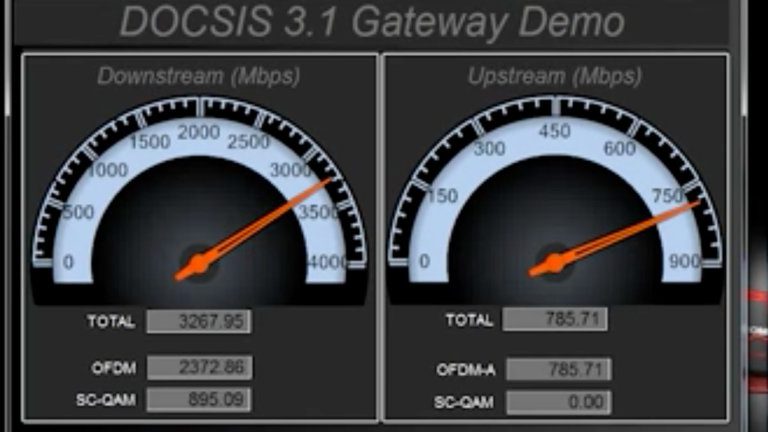
Is the cable industry ready to deliver multi-gigabit broadband? Can the industry effectively compete in the market against fiber? Can the existing HFC plant scale to support the spectrum requirements of next generation services? The answer to all these questions is a resounding YES! as shown at CableLabs during a DOCSIS 3.1 demonstration day held late last month in Colorado.
A healthy ecosystem of twenty-two vendors came together to demonstrate the capabilities and readiness of DOCSIS 3.1 technology on a range of products including cable modems, Converged Cable Access Platforms (CCAPs), and test and measurement equipment.
Demonstrations included
Multi-Gbps Speeds
Multiple vendors demonstrated the ability of DOCSIS 3.1 devices to deliver Multi-Gbps speeds, showcasing downstream capacities up to 4.6 Gbps on the downstream and 800 mbps on the upstream using various combinations of bonded OFDM (OFDMA for upstream) and SC-QAM channels.
Fluid Transition – Backward Compatible, Upgradable, Flexible
ARRIS showcased the capability of DOCSIS 3.1 CCAPs to support both DOCSIS 3.1 and DOCSIS 3.0 cable modems using their E6000 platform, which is currently deployed in the field for DOCSIS 3.0 and can be upgraded via a software update to support DOCSIS 3.1 services.
Casa Systems also showcased their CCAP, which is also currently deployed in the field and can be upgraded via a software update to support DOCSIS 3.1 services.
Vendors showcased a variety of spectrum configurations including downstream OFDM transmissions spanning from 96 to 384 MHz, and upstream transmissions operating with different upstream plant configurations including 5-42 MHz, 5-85 MHz and 5-204 MHz.
Greater Spectral Efficiency
Futurewei and Broadcom showcased DOCSIS 3.1 downstream signals operating at 4096 QAM increasing efficiency by 50% compared to DOCSIS 3.0 technology at 256 QAM, and also showcased 4096 QAM upstream signals increasing efficiency by 100% compared to DOCSIS 3.0 technology at 64 QAM.
Cisco showcased the ability of a DOCSIS 3.1 CCAP to support multiple modulation profiles, which highlights the ability of DOCSIS 3.1 technology to maximize spectral efficiency based on HFC network characteristics.
Future Scalability
Futurewei showcased the optional feature of DOCSIS 3.1 devices to support 16384 QAM, increasing downstream efficiency by 75% compared to DOCSIS 3.0 technology at 256 QAM.
CableLabs is now open for DOCSIS 3.1 device certification testing
The success of the DOCSIS 3.1 demonstrations was not a surprise. CableLabs has been running a series of DOCSIS 3.1 interoperability events (interops) since last December. These events provide the opportunity for manufacturers to work together on interoperability, development, and compliance; and over the course of these events, manufacturers have continued to demonstrate increases in product maturity.
In addition, CableLabs has been holding DOCSIS 3.1 technology dry run events since June to provide additional development opportunities and to evaluate product readiness for certification and field testing through joint test execution.
As was previously announced, CableLabs is now open for DOCSIS 3.1 device certification testing: as soon as products demonstrate readiness through the Dry Run process, certification testing can begin. CableLabs certification programs provide verification of specification compliance; and in the interest of advancing DOCSIS 3.1 device readiness as rapidly as possible, CableLabs will work with device manufacturers in the DOCSIS 3.1 device certification testing process until they can demonstrate this compliance.
The advances in DOCSIS 3.1 device maturity are also born out by the fact that Cable operators have also announced field deployments of DOCSIS 3.1 services as early as Q4 2015.
This is good news for all concerned: DOCSIS 3.1 technology with its support for up to 10 Gps downstream and up to 1 Gps upstream, along with improved network and spectrum efficiency, will enable a new generation of services and applications including advanced video technologies, virtual and augmented reality, tele-existence, etc. DOCSIS 3.1 technology also reduces network latency, and so dramatically improves responsiveness for sophisticated applications such as gaming and rich web experiences.
For cable operators, DOCSIS 3.1 technology provides a flexible migration path for their current HFC deployments since it is backward compatible with legacy DOCSIS devices.
DOCSIS 3.1 technology is living up to its promise to deliver best-in-market speeds to the broadest population of consumers.
DOCSIS 3.1 Demonstration Day Vendor Participation
- Arris
- Askey
- Averna
- Broadcom
- Casa Systems
- Castlenet
- Cisco
- Comsonics
- Excentis
- Futurewei
- Humax
- Intel
- Keysight Technologies
- Netgear
- Pace
- Rohde and Schwarz
- Sagemcom
- ST Microelectronics
- Technicolor
- Trilithic
- Ubee
- Viavi
Comcast’s DOCSIS 3.1 Gateway was also included in the demonstrations.
Matt Schmitt, Vice President of Lab Services, CableLabs, also contributed to this article.
Belal Hamzeh is Director of Network Technologies at CableLabs.
DOCSIS
DOCSIS 3.1® Update: Get Your Engines Running…. The Engines ARE Running!
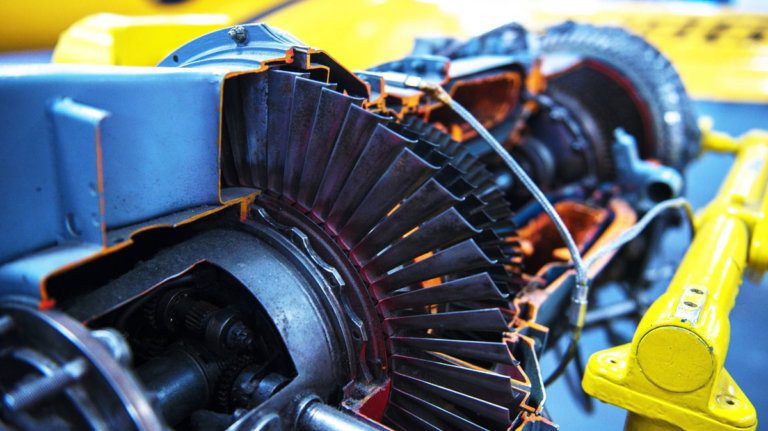
The original title for this blog was supposed to be “DOCSIS® 3.1 Update: Get your engines running,” but in reality, the engines ARE already running! In fact, the DOCSIS 3.1 engines have been running hot since the start of the year. With the technology rapidly maturing, vendors have accelerated their product development. Let’s take a look at some of the milestones we have hit over the past year as the DOCSIS 3.1 ecosystem evolved.
Progress
Last December we held the first official DOCSIS 3.1 equipment interoperability event (interop). Since then, four more interops have been successfully completed. The next one is scheduled for September. All the interops have been very successful, with strong vendor participation, including CM (cable modem) vendors, CMTS (cable modem termination system) vendors, and test equipment vendors. In the initial interops, we saw visible signs of how DOCSIS 3.1 technology will change the industry including the delivery of multi-Gbps performance, and high order modulation densities never seen before in other technologies – both showcasing the capabilities of DOCSIS 3.1 networks even before the equipment has been deployed.
It is also exciting to see how the ecosystem is collectively working to ensure that DOCSIS 3.1 technology is ready for deployment in cable networks. Along with the progress made by the CM and CMTS vendors, we have also seen excellent progress from test equipment vendors, who are preparing the right tools to support DOCSIS 3.1 field deployments. We are very excited that cable network operators are now priming their networks for DOCSIS 3.1 readiness through field testing and trials. Early results show that the utilization of high order DOCSIS 3.1 modulation schemes will significantly increase network efficiency.
With the great strides in product development, CableLabs® has also opened the door for DOCSIS 3.1 product certification submissions. We expect to see product submissions for certification in the near future.
Based on what we have learned, and all the excitement from the vendors and operators, we expect the upcoming DOCSIS 3.1 deployments to drive the next evolution in broadband connectivity.
Stay tuned for further updates ….
Belal Hamzeh is the Director of Broadband Evolution at CableLabs.
DOCSIS
DOCSIS 3.1: Where We Are Today
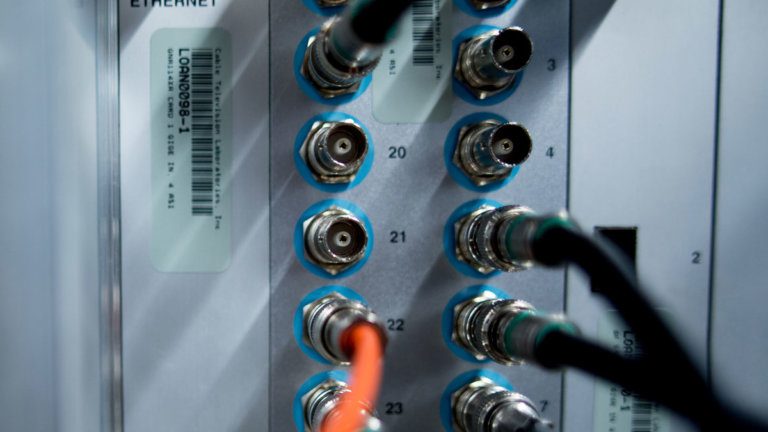
The NCTA recently announced Gigasphere, which encompasses the new experiences customers will come to enjoy based on the DOCSIS 3.1 technology developed by CableLabs, Inc.
There is a lot of excitement around DOCSIS 3.1, and the new capabilities it will bring to cable networks for cable operators and their customers. Customers will be able to enjoy gigabit speed access on the downstream and upstream, allowing them to download 4K video and ultra-high definition movies faster than ever. Reduced network delay will also take the online gaming experience to a new height, increasing responsiveness and allowing higher resolution graphics. Also, the widespread availability of cable high-speed internet will make the benefits of DOCSIS 3.1 available to over 90% of U.S. households.
Cable service providers, in addition to being able to provide richer experiences to their customers, will have an easier time maintaining their networks due to the Proactive Network Maintenance functionalities embedded into DOCSIS 3.1; thus being able to provide a more consistent and reliable experience to their customers.
Looking back, it has been just over 18 months of intense work, collaboration and innovation across technology vendors and MSOs since we started the DOCSIS 3.1 project, reaching our first public milestone in November 2013 by publishing the first official release of the DOCSIS 3.1 specification – and we are not done yet! We are planning for our first round of equipment interoperability testing later this year, and we expect to see devices ready for certification by the middle of 2015.
Also, CableLabs is working with several MSOs to to make sure the networks are ready when DOCSIS 3.1 devices hit the market. We are engaged in a wide range of HFC network testing activities to prime the network to support the higher capacities enabled by DOCSIS 3.1.
Finally, to increase the ecosystem technical expertise around DOCSIS 3.1, CableLabs will be hosting a DOCSIS 3.1 training session June 2- June 5 for attendees to gain an in-depth understanding of DOCSIS 3.1.
These are exciting times at CableLabs, so much has been accomplished, and there is much more to look forward to!
Stay tuned for further updates ....
For more information, please contact Belal Hamzeh.
Belal Hamzeh is the Director of Broadband Evolution at CableLabs, leading the DOCSIS 3.1 activities, in addition to being the Principle Architect for the DOCSIS 3.1 Physical and RF Layers. He has been heavily involved in developing broadband technologies for wired and wireless networks and variety of applications for over 10 years.


